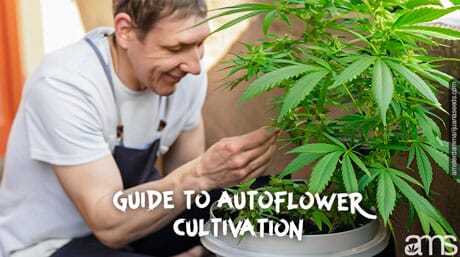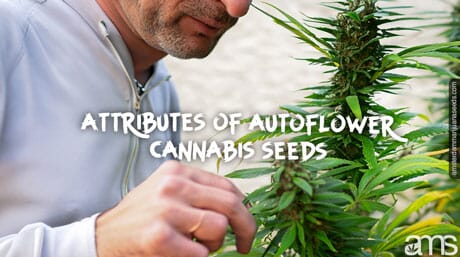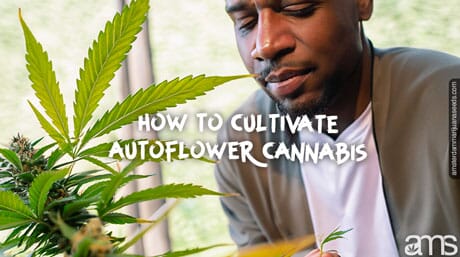marijuana growing
Guide to Autoflower Cannabis Seeds and Their Cultivation
Published
11 months agoon
By
admin
AMS’s autoflower cannabis seeds stand as a shining example of hassle-free cultivation. These seeds symbolize autonomy, seamlessly steering your cannabis plant from germination, through the vegetative phase, and finally into the flowering stage, without any complex intervention or manipulation of light cycles by the cultivator.
Our superior autoflower seeds are carefully designed to generate the highest yield in the shortest time possible. We encourage you to experience the potency of our Amsterdam seeds first hand!
Acquiring Autoflower Cannabis Seeds
Autoflower seeds offer an incredibly adaptable crop that combines easy management with swift growth, making them a popular choice for beginners. We highly recommend you familiarize yourself with our extensive cultivation guide before setting off on your gardening journey. With autoflower cannabis seeds, cultivators can look forward to a potential bountiful harvest, rich with cannabinoid-loaded buds.

Understanding Autoflower Cannabis Seeds
Autoflower seeds are a unique variety of cannabis seeds that can flower independently with minimal reliance on external growth factors. These seeds have been so precisely calibrated that they easily override the light cycle dependency that feminized seeds require for a rich harvest.
Autoflower seeds are available in multiple types and can be adjusted to be THC-rich, CBD-dominant, or evenly balanced. They can also exhibit a broad spectrum of terpene profiles, enhancing their appeal. Their hardy nature and swift growth cycle make these strains a go-to for beginners and those looking for a quick yield.
To truly understand and appreciate the singular nature of this strain, one must explore the cannabis growth cycle. Comprising two primary phases – the vegetative phase and the flowering phase – each stage necessitates specific conditions for seamless progression and accurate transition.
In the case of feminized strains, the flowering phase is dependent on reduced light. These strains, often referred to as photoperiod cannabis strains, require a significant change in light cycles to prompt the flowering phase. This is not so with autoflower strains. Their flowering is triggered by an internal biological clock rather than light dependency, displaying a major distinction with these strains.
The autoflowering characteristics can be traced back to the cannabis subspecies ruderalis. Native to the harsh climates of Central Asia, Eastern Europe, and Russia, this species evolved the autoflowering trait as a survival mechanism in its severe native habitat. This inherent trait ensures that the plant completes its reproductive cycle before the onset of extreme cold. Researchers at Amsterdam Marijuana Seeds have utilized this natural adaptation to produce the speedy-growth, high-yield autoflower seeds currently accessible to cultivators.
Attributes of Autoflower Cannabis Seeds
Autoflower seeds have several notable attributes. While they provide numerous advantages to cannabis cultivators, some characteristics might be less favorable. Here are some of the key traits to note:
Swift life cycle: Autoflower strains typically reach maturity far earlier than other strains. The average plant ripens within 8 – 10 weeks from seed to harvest.
Inconspicuous growth: These plants are compact, allowing them to blend in, enabling indoor cultivation, even within living spaces.
Minimal light requirements: Unlike other strains, autoflower seeds don’t demand high light levels. Their unique capability is their power to self-pollinate and flower within a predetermined timeframe, irrespective of external light cues.
Unparalleled toughness: Among cannabis strains, these are some of the sturdiest you can come across. They can prosper under some of the harshest conditions, making them a favored choice for novice growers still acclimating themselves with cannabis cultivation and its distinct needs.
Lower nutrient needs: Autoflower strains demonstrate remarkable survival skills. They don’t require intensive care or a strict routine to thrive. Their rugged nature enables them to survive in nearly all conditions.
However, every advantage has a drawback. Autoflower strains may produce a smaller yield compared to feminized seed strains. Furthermore, these strains are nearly impossible to clone effectively, and when cloned, often yield inferior results.

Who Can Benefit From Autoflower Cannabis Seeds?
Autoflower seeds are a top choice for novice growers and home gardeners. Their self-sufficient growth pattern means they don’t need any specialized equipment or strictly regulated environments to prosper. Their autoflowering feature makes them ideal for discreet cultivation indoors and outdoors.
How To Cultivate Autoflower Cannabis Seeds
Autoflower seeds are highly flexible and can prosper in almost any setting. Although indoor cultivation under regulated conditions can enhance yield and overall plant performance, it’s not a requirement. For a comprehensive understanding, refer to our guide titled “How to Grow Autoflower Seeds”.
Consider trying the following highly recommended autoflower cannabis seed strains:
How to sprout autoflower seeds?
Follow the steps below for successful sprouting:
- Dampen two paper towels and place your autoflower seeds on them.
- Fold the paper towel over the seeds and place it on a plate.
- Shield this setup with another plate.
- Store the plates in a warm, dark location.
- Check daily to ensure the paper towels maintain their moisture.
- When the radicle root exceeds 1 cm, your seeds have sprouted successfully.
How to cultivate autoflower seeds outdoors?
- Sprout your autoflower seeds in their final growth container (preferably holding more than 10 liters).
- Position the container to get a minimum of 8 hours of direct sunlight.
- Water your seedlings daily to ensure they stay properly hydrated.
- Nourish your autoflower seeds using a slow-release approach.
- Approximately 12 weeks after sprouting, you should be ready to harvest your plant.
Autoflower seeds, with their durable nature and fast growth cycle, offer a multitude of advantages to cannabis cultivators. Perfect for beginners and those with limited space or resources, these hardy seeds take the unpredictability out of growth light cycles, making cultivation more straightforward and predictable.

However, it’s vital to ensure ideal conditions for sprouting. Even though autoflower seeds are adaptable, they still require basic care for successful sprouting. Soil temperature, moisture levels, and aeration significantly affect the sprouting success rate.
A soil temperature of around 25℃ is considered optimal for these seeds. It’s also crucial to maintain a balance in soil moisture levels – the soil should be damp but not waterlogged. Overwatering can obstruct oxygen flow to the seeds, resulting in stunted growth or even seed decay. Aeration plays a critical role in successful sprouting. It helps in preventing mold and fostering a healthier root system for the plant.
Once these conditions are met, you can expect the seed to sprout within one to three days. The main indicator of successful sprouting is the emergence of a small stem protruding from the soil surface, marking the commencement of a new growth phase.
For more detailed instructions and tips on the sprouting process, consider visiting this thorough guide. This step-by-step guide not only provides insights into successful seed sprouting but also discusses potential pitfalls and how to evade them, ensuring a more successful cultivation experience.
Frequently Asked Questions
Autoflower seeds offer an incredibly adaptable crop that combines easy management with swift growth, making them a popular choice for beginners. These seeds provide an opportunity for novice growers to experience a potential bountiful harvest, rich with cannabinoid-loaded buds, without the need for complex intervention or manipulation of light cycles. Question: How do autoflower cannabis seeds differ from feminized seeds in terms of flowering?
Autoflower seeds are a unique variety of cannabis seeds that can flower independently with minimal reliance on external growth factors. Unlike feminized seeds that require a significant change in light cycles to prompt the flowering phase, autoflower seeds are triggered by an internal biological clock. This distinction allows autoflower seeds to bypass the light cycle dependency, resulting in a quicker growth cycle and the ability to flower without specific light manipulation.
Autoflower seeds are a top choice for novice growers and home gardeners. Their self-sufficient growth pattern means they don’t need any specialized equipment or strictly regulated environments to prosper. With their autoflowering feature, they are ideal for discreet cultivation both indoors and outdoors, making them accessible to a wide range of cannabis cultivators.
Disclaimer: This content is meant for educational purposes only. It has been compiled with research from external sources. it is not meant to substitute any medical or legal advice. Please see your local laws for the legality of cannabis use.
You may like
-


Is Your Kid Smoking or Vaping Weed?
-


Press Release: PsychedelicNewsWire Named Official Media Sponsor of the 4th Annual Psychedelic Therapeutics and Drug Development Conference
-


Memorial Day’s best weed, prerolls, carts, and more 2024
-


Naps Done Right Can Make a Huge Difference
-


Michigan is selling more cannabis, but retailers are taking in less money
-


Can Marijuana Give A Break From All The Drama
marijuana growing
Boost Your Autoflowers with the Best Organic Fertilizers
Published
1 week agoon
May 9, 2024By
admin
If you are considering increasing your yield with fertilizers, you have many decisions to make. It starts with selecting one of the two principal types of cannabis fertilizers –synthetic or organic. You also need to understand the nutrients needed at different stages of cannabis growth. With this information, you can easily select the best fertilizer that fits your growing operation.
Fertilizer application for autoflowers
Auto-flowering strains are developed from the Cannabis ruderalis genetics. Cannabis strains with the auto-flowering trait depend on time and age to transition into the flowering stage. This means these plants automatically transition from the germination stage to flowering without the need for light cycle modifications. Since flowering is automatic, you would expect that these cannabis plants complete their growth cycle within a short window. However, within this period, they also rapidly absorb nutrients from the soil. These nutrients are needed for rapid cellular rearrangement, root system development, bud formations, and stem growth.
The nutrient absorption rate is high, and the plant can quickly exhaust the soil’s deposit of nutrients. This frequently happens in regions where the soil is practically poor in Nitrogen, potassium, and phosphorus. Autoflowering cannabis seeds, in many cases, need fertilizers to complete their growth cycle. Experienced cannabis farmers always have their preferred fertilizers handy as the plants start growing. In this review, we have compiled a list of the best organic fertilizers you should consider.
Why should you use organic fertilizers for autoflowers?
Both synthetic (commercially available) and organic (homemade) fertilizers are suitable for autoflowers. However, there are many reasons why you would want to consider using an organic fertilizer. Though not exclusive, here are some of the reasons to consider organic fertilizers;
1. Organic fertilizers are cheap on sale
If you are just starting on planting your first few stands of auto-flowers, you don’t want to overstretch your budget. Using organic fertilizers might help you spend less. Compared to synthetic fertilizers, the production cost for organic fertilizers is lower. The raw materials needed can be easily sourced from the environment. If you have the necessary skills, you can make these fertilizers right at home and apply them at no cost whatsoever.
2. Easily customizable
You can easily customize the nutrient content of your organic fertilizer. Synthetic fertilizers are sold in a fixed NPK ratio. Once produced, these fertilizers can only supply the component nutrients in a fixed ratio. For organic fertilizers, if you know which component supplies which nutrient, you can easily prepare fertilizer with different nutrient ratios.
3. No environmental and health hazards
Perhaps this is one of the biggest reasons many cannabis farmers prefer organic fertilizers for auto-flowers. The raw material is biodegradable, constituting no huge hazard to the environment. Since they also contain no synthetic chemicals, organic fertilizers constitute no serious health hazard. You can safely apply them without worries about getting a chemical reaction.
4. No adverse effect on harvest
You can be sure that your harvest is safe with organic fertilizers. Some synthetic fertilizers can interfere with the taste, flavor, and odor of cannabis plants. This is because residual chemicals present in these formulations can be absorbed directly into the plant’s system. With organic fertilizers, the formulation contains no residual chemicals as they are made from natural components. Your cannabis harvest is safe with its desirable features carefully preserved.
Our selection of the best organic fertilizers for auto-flowers
1. Organic superSoil
Getting it right with organic fertilizers all starts with the soil. The organic soil recipe –commonly described as ‘Supersoil’ –is one of the widely used organic growth mediums for auto-flowers. The soil is enriched with organic raw materials that are gradually decomposed over the years. The nutrients are decomposed over time into a form that the plant can easily absorb. There are various recipes and steps for mixing a SuperSoil. However, the components are always almost the same. You can modify the quantity of each component depending on the nutrient profile you need from the soil. One of the widely adopted mix ratios for autoflowers is the Ballpark recipe. Check the recipe below;
50% peat- or sphagnum-based soilless mix (provides the bulk of the medium)
10-20% mature compost (some organic nutrients + lots of microbes)
10% earthworm castings, or vermicompost (the same)
10% perlite (helps saturate the medium with O2, which is necessary for roots)
fungi/mycorrhizae/bacteria (turn raw organics into available plant food)
The fungi/mycorrhizae/bacteria component is very important. This organism plays two principal roles in Supersoils –they help decompose other components and also help the auto-flowers absorb these nutrients by binding to the plant root.
2. Bat guano
Bat poo, commonly called ‘Bat Guano,’ is a conventional organic fertilizer used in many planting operations. For thousands of years, local farmers with no access to synthetic fertilizers reportedly used bat guano. Since it works, this organic fertilizer option has survived many years of history. Today, rural farmers still use it as organically sourced fertilizer. Cannabis farmers also use Bat Guano as an organic source of Nitrogen, Phosphorus, and potassium. You can prepare bat guano in powder form or as a pre-made extract in the form of aerated tea.
Depending on the diet of the bat and its location, Bat Guano preparation can have a rich supply of both macro-and micronutrients needed by autoflowers.On harvesting the dried guano, you mix it into compost or apply it directly to the growth medium. Its rich deposit of phosphorus particularly makes it a preferred booster during the blooming period. Depending on the lay of your farm and the prevailing weather conditions, you can be creative with how you use Bat guano.
3. Manure
Manure can also serve as the right organic fertilizer for your autoflower. Primary manures are decomposed animal waste gathered from farms. Farmers who cultivate their cannabis in regions where livestock farming is a big deal prefer manual as an organic fertilizer. Since it can be readily sourced, the cost of production is very cheap. Manure offers a balanced nutrient profile for autoflowers. It also conditions the soil, making it a natural depot of plant nutrients. This deposit of nutrients makes it possible to grow autoflowers multiple times within the same cannabis planting season. For locally collected manures, composting is very important to make sure the manure does not damage the plant. Some of the most commonly prepared manure for autoflowers include;
- Chicken Manure: Manure sourced from chicken waste is high in Nitrogen. This makes a perfect option for autoflowers during the vegetative stage. Chicken manure also provides a lasting nutrient supply beyond the vegetative stage. Proper composting is needed.
- Sheep and Rabit manure: This manure is especially good for cannabis plants in the flowering stage. Although not often found in abundance, cheap rabbit manure comes naturally in an easy-to-apply pellet form.
- Composted Horses or Steers Manure: Unlike others, horses’ compost manure is produced as a cool material. This makes it easier to apply without burning the plant. They also produce a rich nutrient profile and contain beneficial organisms that can help autoflowers grow rapidly.
4. Compost tea
Though not very common, compost tea is another organic fertilizer you can consider for your autoflowers. This liquid concentrate contains soluble nutrients and microorganisms from compost materials. The key ingredients needed to make a compost team include compost. Worm casting, fish hydrolases, kelp, and molasses. The compost should have a large population of beneficial microorganisms. The worm castings are byproducts expelled from worms after digestion is completed. Kelp and molasses serve as food for fungi and bacteria that grow while the tea is brewing.
Once ready, the tea can be diluted and applied directly to the roots or sprayed on the autoflower leaves. Do not apply compost tea over an irrigation line to avoid clogging. It is also important that you apply a potent dose to a few autoflowers first and check for any adverse effects on the leaves after a few hours.
Bottom line
Growing your autoflowers with organic fertilizers is a good method of improving plant yield. The raw material needed for most organic fertilizers is locally available. You save time, energy, and resources if you choose organic fertilizers. You might also require the help of a botanist or agrochemical expert to help with any additional materials you might need. Buy autoflowering weed seeds here, great quality straight from Amsterdam
marijuana growing
“2024 Lunar Calendar Guide for Cannabis Cultivation Success”
Published
2 months agoon
March 12, 2024By
admin
Lunar Calendar for the 2024 Growing Season
Discover how the lunar phases in 2024 influence key moments in cultivation:
Germination: Perform germination during the full moon in fire signs (Aries, Leo, Sagittarius) on dates like January 25 and May 23.
Soil Preparation: Take advantage of specific dates, such as February 27 and March 24, to prepare the substrate during the waning moon in Virgo.
Transplant: Transplant during the waxing moon in water signs (Cancer, Scorpio, Pisces) on dates like March 20 and June 9.
Training and Pruning: Apply training techniques during the waxing moon in water constellations (Pisces, Cancer, Scorpio) on dates like March 11 and June 9.
Fertilization: Fertilize during the waning moon in water signs on dates like March 3 and June 29.
Harvest: Opt for harvesting in air constellations (Gemini, Libra, Aquarius) during the waxing moon or full moon on dates like September 17 and August 19.
Follow the lunar calendar and enhance your marijuana cultivation for exceptional harvests in 2024.
Cultivation of Cannabis at Home:
With the advancement of legalization in various parts of the world, there is a growing interest among individuals to cultivate their own marijuana plants at home. However, it is of utmost importance to approach this subject with responsibility and awareness, as marijuana cultivation involves legal and safety responsibilities. Additionally, proper cultivation management not only ensures compliance with regulations but also contributes to obtaining optimal plant quality, avoiding the use of chemicals that could harm its natural development and life cycle. This responsible approach not only promotes healthy cultivation but also safeguards the integrity of the environment and the well-being of those involved in this practice.
1. Legality and Regulations:
It is essential to start any cultivation project with a clear understanding of local laws and regulations. In many places, the possession and cultivation of marijuana are regulated, and even in areas where it is legal, there are limits on the number of allowed plants. Being informed about local regulations is crucial to avoid legal issues.
2. Seed Selection:
Choosing the right seeds is a crucial step. There are varieties with different levels of THC and CBD, as well as autoflowering options that simplify the process. Researching and selecting seeds that suit your needs and skills are key to successful cultivation.
3. Controlled Environment:
Creating a controlled environment is essential for the healthy growth of plants. Marijuana requires specific conditions of light, temperature, and humidity to thrive. Installing a suitable lighting system and regulating the climate are important considerations.
4. Nutrients and Irrigation:
Providing the right nutrients in the correct amounts is vital for plant development. Novice cultivators often underestimate the importance of a well-balanced nutrient program. Additionally, proper irrigation, avoiding both excess and scarcity, is fundamental to prevent issues such as mold and root rot.
5. Security and Discretion:
Maintaining security and discretion is crucial, especially if you live in an area where marijuana cultivation is subject to legal restrictions. Ensure that your cultivation space is protected and out of reach of unauthorized individuals.
100% Natural Cultivation:
With the appropriate knowledge and a consistent commitment to best practices, home cultivators can reap the rewards of a successful cultivation, respecting both laws and safety standards. It is crucial to consider the natural cycles of the moon, leveraging its benefits for plant development. Additionally, exploring various techniques that promote the natural growth of the plant is advisable, ensuring exceptional quality. It is worth noting that this process ensures a cultivation free of chemicals, which is essential to preserve plant quality and, consequently, the safety of human consumption.
marijuana growing
44K Job Opportunities by 2030
Published
3 months agoon
February 12, 2024By
admin
By: Juan Sebastian Chaves Gil
With sales exceeding $70 million during the II National Cannabis and Hemp Summit in Cali, it is clear that the medicinal and industrial sector of this crop is driving the country’s economy. Entrepreneurs, experts, and representatives were integral parts of this event, whose purpose is to demystify misconceptions about cannabis and support entrepreneurs in their formalization process.
Pedro Andrés Bravo, Secretary of Economic Development and Competitiveness of Valle, emphasized that this sector promotes inclusion and projects the creation of more than 44 thousand jobs by the year 2030. For this reason, Valle del Cauca leads the Business Justification and Diversification Index, pioneering in demonstrating the potential of this market.
The National Cannabis and Hemp Summit, led by the Government of Valle del Cauca, has become the most relevant event since the approval of the law on medicinal and industrial cannabis in the country.
According to Agronegocios, Valle del Cauca ranks fifth in national cannabis production, representing 2% in the year 2021.
Valle del Cauca stands out as the first department with a Medicinal and Industrial Cannabis production chain, coordinating the activities of 220 producers.
David Pérez, director of Mercannábico, the first Amazon-type marketplace for the cannabis industry in Colombia, emphasized the importance of these events to counteract the misinformation that has affected the sector. He highlighted that cannabis needs everyone to connect and that Colombia perceives it not as a problem but as a solution to medical ailments.
Estefanía Patiño Valencia, advisor to the Office of Social Management of Valle, pointed out that the summit managed to bring together the Ministries of Justice and Health, ICA, and Invima. All requests for the development of the industry were processed, and a departmental commitment was established with elected mayors, deputies, and councilors to work together for this sector.

Is Your Kid Smoking or Vaping Weed?

Press Release: PsychedelicNewsWire Named Official Media Sponsor of the 4th Annual Psychedelic Therapeutics and Drug Development Conference

Memorial Day’s best weed, prerolls, carts, and more 2024

Naps Done Right Can Make a Huge Difference

Michigan is selling more cannabis, but retailers are taking in less money

Can Marijuana Give A Break From All The Drama

Consumer Spending Validates Marijuana Rescheduling

How Did Hidden Leaf Cannabis Become the Leader of the Ontario Marijuana Market?

Are You Bored So You Smoke Weed or Do You Smoke Marijuana and Get Bored?

Cannabis Rescheduling Takes The Next Steps

Distressed Cannabis Business Takeaways – Canna Law Blog™

United States: Alex Malyshev And Melinda Fellner Discuss The Intersection Of Tax And Cannabis In New Video Series – Part VI: Licensing (Video)

Drug Testing for Marijuana – The Joint Blog

What you Need to Know

Cannabis, alcohol firm SNDL loses CA$372.4 million in 2022

NCIA Write About Their Equity Scholarship Program

City Of Oakland Issues RFP For Employee Training Programs

It has been a wild news week – here’s how CBD and weed can help you relax

A new April 20 cannabis contest includes a $40,000 purse

UArizona launches online cannabis compliance online course
Trending
-

 Cannabis News1 year ago
Cannabis News1 year agoDistressed Cannabis Business Takeaways – Canna Law Blog™
-

 One-Hit Wonders1 year ago
One-Hit Wonders1 year agoUnited States: Alex Malyshev And Melinda Fellner Discuss The Intersection Of Tax And Cannabis In New Video Series – Part VI: Licensing (Video)
-

 drug testing5 months ago
drug testing5 months agoDrug Testing for Marijuana – The Joint Blog
-

 Cannabis 1011 year ago
Cannabis 1011 year agoWhat you Need to Know
-

 Marijuana Business Daily1 year ago
Marijuana Business Daily1 year agoCannabis, alcohol firm SNDL loses CA$372.4 million in 2022
-

 Education1 year ago
Education1 year agoNCIA Write About Their Equity Scholarship Program
-

 Education1 year ago
Education1 year agoCity Of Oakland Issues RFP For Employee Training Programs
-

 Cannabis1 year ago
Cannabis1 year agoIt has been a wild news week – here’s how CBD and weed can help you relax



